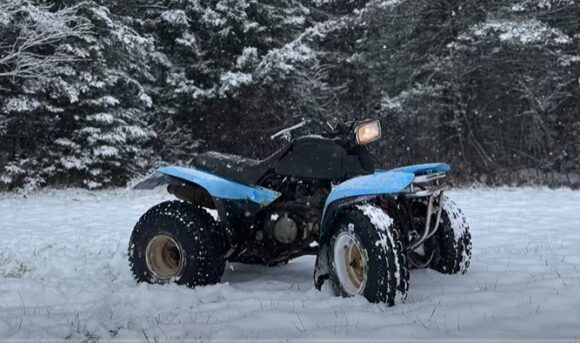ATVs are widely used for many purposes. The Honda Rincon and Rubicon are two of the top products on the market. Although at first glance they could appear to be similar, they have definite characteristics that make them unique.
Both the Rincon and the Rubicon have strong motors, outstanding suspensions, and flexible handling. There are, however, a number of things to take into account while selecting the ideal ATV.
To assist you in choosing the ideal ATV, the Honda Rincon and Rubicon will be thoroughly compared in this post.
Honda Rincon vs Rubicon: Quick Comparison Table
| Features | Honda Rincon | Honda Rubicon |
| Engine | 675cc liquid-cooled OHV semi-dry-sump | 518cc liquid-cooled |
| Bore and Stroke | 102mm x 82.6mm | 96.0mm x 71.5mm |
| Compression Ratio | 9.2:1 | 9.5:1 |
| Valve Train | OHC; four valves per cylinder | OHV; two valves per cylinder |
| Induction | Electronic fuel injection (EGM-FI), 40mm throttle body | Programmed Fuel Injection (PGM-FI); 36mm throttle body |
| Starter | Electric with auxiliary recoil | Electric with optional auxiliary recoil |
| Transmission | Automatic with three forward gears | Five-speed automatic dual-clutch transmission |
| Suspension | Front – 6.9-inch Independent double-wishbone Rear – 8.0-inch travel | Front – 7.3-inch Independent double-wishbone Rear – 8.5-inch travel Independent dual-arm |
| Brakes | Front – Dual 180mm disc Rear – 170mm disc | Front – Dual 190mm discs Rear – Dual 170mm discs |
| Tires | Front – 25 x 8-12 Rear – 25 x 10-12 | Front – 25 x 8-12 Rear – 25 x 10-12 |
| Fuel Capacity | 3.9 gallons, including a 1.3-gallon reserve | The five-speed automatic dual-clutch transmission |
| Towing Capacity | 848 pounds | 1322 pounds |
| Image |
What Are the Differences between the Honda Rincon and Rubicon? (Explained)
Both the Honda Rincon and Rubicon are excellent ATVs, but there are some significant distinctions between them. The Rincon’s engine is bigger than the Rubicon’s.
The Rubicon has a more sophisticated automatic transmission system. The ground clearance of the Rincon is also less than that of the Rubicon.
Here are a few brief observations of these two ATVs:
1. Engine:
The Rincon has a larger, single-cylinder, longitudinally-mounted, liquid-cooled 675cc engine. It has a 4-stroke, OHV, semi-dry-sump engine that is more potent than the Rubicon’s 518cc engine.
The Rincon’s engine generates greater horsepower and torque, making it more suitable for demanding tasks or off-road excursions.
The Rubicon, on the other hand, has a single-cylinder, four-stroke engine that is longitudinally mounted and liquid-cooled. Compared to the Rincon, it features a smaller engine. The capacity is low even if it may produce the same amount of power.
2. Bore and Stroke:
In contrast to stroke, which describes how far the piston travels up and down inside the cylinder, bore describes the diameter of the cylinder.
The displacement of the engine increases with its bore and stroke, which can lead to a higher output of horsepower and torque.
In comparison to the Honda Rubicon’s 96.0mm x 71.5mm bore and stroke, the Honda Rincon measures 102mm x 82.6mm.
The Honda Rincon has a greater engine displacement than the Honda Rubicon due to its larger diameter and stroke specs.
The ATV may be able to operate more effectively in challenging off-road conditions as a result of increased power and torque.
3. Compression Ratio:
The ratio of the cylinder’s volume at the bottom to the height of the piston’s stroke is called compression ratio.
When the fuel and air combination in the engine’s combustion chamber has a higher compression ratio, it is compressed to a smaller volume before being ignited. This results in more power and efficiency.
The Honda Rubicon features a larger compression ratio of 9.5:1 than the Honda Rincon, which has a 9.2:1 compression ratio.
As a result, the Honda Rubicon has a greater compression ratio than the Honda Rincon. This enables it to create more power while using less fuel.
Greater engine stress from a greater compression ratio, on the other hand, might result in engine knocking or overheating.
4. Valve Train:
With four valves per cylinder, the Honda Rincon uses an overhead camshaft (OHC) valve train. There are two overhead valves (OHV) per cylinder in the Honda Rubicon’s valve train.
Above the cylinder head on the Rincon’s camshaft is an OHC valve train that directly controls the valves using a series of rocker arms.
On the Rubicon, an OHV valve train is housed inside the engine block and indirectly controls the valves via pushrods and rocker arms.
The Rincon’s four valves per cylinder provide effective and complete combustion. This results in increased power and fuel efficiency.
Additionally, compared to OHV systems, the OHC architecture might offer superior engine response and higher RPM potential.
5. Induction:
A 40mm throttle body is part of the Honda Rincon’s Electronic Fuel Injection (EGM-FI) system. A smaller 36mm throttle body is part of the Programmed Fuel Injection (PGM-FI) technology in the Honda Rubicon.
Systems based on electronic fuel injection (EFI) are often more sophisticated and accurate than older systems based on carburetors. Performance and fuel economy both improve as a consequence.
The Rincon can draw more air into the engine thanks to its bigger 40mm throttle body. Power and torque may increase as a result.
A bigger throttle body can also result in better acceleration and throttle response.
The smaller 36mm throttle body on the Rubicon might not be able to deliver as much airflow. As a result, power and acceleration are marginally reduced.
However, it still has decent performance and exceptional fuel efficiency.
6. Transmission:
The automatic transmission of the Honda Rincon incorporates a hydraulic torque converter. It also has electronic controls, reverse, and three forward speeds.
The Honda Rubicon, on the other hand, features a dual-clutch, five-speed automatic transmission. The Rincon’s automatic transmission sends power from the engine to the wheels through a hydraulic torque converter.
The torque converter makes it possible for the engine to keep operating even when the ATV is stopped.
The electronic controls can also aid in improving the transmission’s efficiency.
The five-speed automatic dual-clutch transmission on the Rubicon employs two different clutches to change ratios. A dual-clutch transmission can offer smoother and quicker gear changes.
7. Suspension:
The independent double-wishbone suspension of the Honda Rincon has a front travel of 6.9 inches and a rear travel of 8.0 inches.
The independent double-wishbone suspension in the front and independent dual-arm suspension with 8.5 inches of travel each are featured on the Honda Rubicon.
Both have independent double-wishbone suspensions, which enable each wheel to move independently.
The Rubicon’s front suspension has 7.3 inches of travel which can absorb bigger shocks and bumps.
The independent dual-arm rear suspension of the Rubicon adds to the vehicle’s stability and handling.
8. Brakes and Tires:
With 25 x 8-12 front tires and 25 x 10-12 rear tires, the Honda Rincon and Honda Rubicon feature similar tire widths. The braking systems on the two ATVs are where the primary differences lie.
The Rincon sports a single 170mm disc brake in the back and a dual 180mm disc braking system up front. On the other hand, the Rubicon features twin 170mm disc brakes in the back and dual 190mm disc brakes up front.
In comparison to the disc brakes on the Rincon, the Rubicon’s bigger disc brakes may provide higher stopping force and heat dissipation.
Cost Detail of Honda Rincon vs Rubicon
The price of a Honda Rincon or Rubicon ATV can change based on a number of variables, including the model, location, and dealer.
The basic MSRP of the 2023 Honda Rincon is more expensive than the base MSRP of the 2024 Honda Rubicon, coming in at $9,599 against $9,399.
It’s important to keep in mind that other charges like the destination fee and freight surcharge, which are $420 and $200 respectively for both models, are the same.
Consequently, there is a $200 price difference between the two variants. It’s critical to remember that costs might change based on the dealership and region.
Yamaha Grizzly vs Honda Rubicon
Signs of Faulty Honda Rancher Angle Sensor
Honda Foreman 500 Angle Sensor Reset


